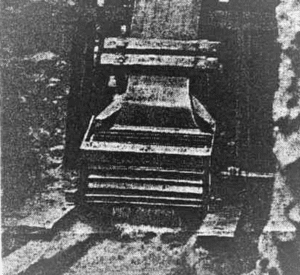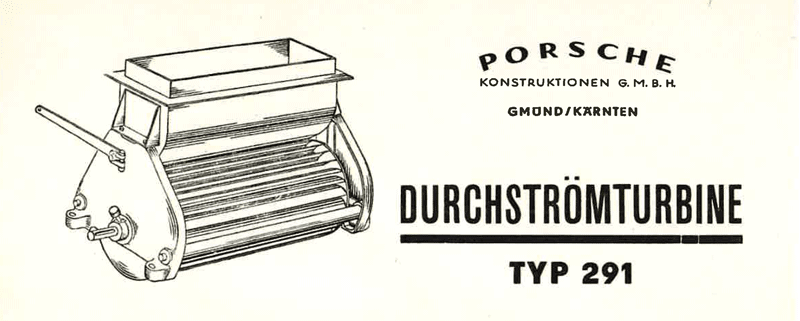Original 1949 Porsche Konstruktionen GesmbH (Gmünd) water turbine now in fahr(T)raum
In the years between 1944 and 1950, the Porsche works in Gmünd/Carinthia, which operated under the name Porsche-Konstruktionen-Ges.m.b.H., produced not only the Porsche 356 No. 1 Roadster but also designs for racing cars, tractors, cable winches, ski lifts and crossflow turbines.
The Type 291 crossflow turbine – on loan from the Porsche Automuseum in Gmünd – is currently on exhibit at fahr(T)raum. “We have been working together with the Porsche Museum in Gmünd for a long time and have a very strong and dear partner in the Pfeifhofer family,” says Jakob Iglhauser, Managing Director of the fahr(T)raum classic car museum in Mattsee near Salzburg.
 The turbine was used, inter alia, to drive sawmills, mills and agricultural machinery. It was also used to generate electricity. The advantage over the traditional water wheel was the significantly higher speed of the turbine, with which a higher output – even with a smaller water volume – could be achieved. The nozzle could be regulated by hand. The turbine was recommended for the “economic utilisation of small hydropower plants” for a power output of 4 to 20 HP for a fall height (drop) of 2.4 to 6 metres or a power output of 40 HP for a drop of 10 metres. It consists mainly of sheet steel parts welded together, the impeller runs on ball bearings. According to the original instruction handbook, maintenance is limited “to daily retightening of the lubricators provided on the bearing bodies and refilling these lubricators with grease after a longer period of operation.”
The turbine was used, inter alia, to drive sawmills, mills and agricultural machinery. It was also used to generate electricity. The advantage over the traditional water wheel was the significantly higher speed of the turbine, with which a higher output – even with a smaller water volume – could be achieved. The nozzle could be regulated by hand. The turbine was recommended for the “economic utilisation of small hydropower plants” for a power output of 4 to 20 HP for a fall height (drop) of 2.4 to 6 metres or a power output of 40 HP for a drop of 10 metres. It consists mainly of sheet steel parts welded together, the impeller runs on ball bearings. According to the original instruction handbook, maintenance is limited “to daily retightening of the lubricators provided on the bearing bodies and refilling these lubricators with grease after a longer period of operation.”
The turbine was produced in two types – type 291/1 (490 kg, max. height 760 mm, max. length 1250 mm) and type 291/2 (390 kg, max. height 740 mm, max. length 750 mm). The purchase and installation of the turbine was affordable even for economically weak mining operations.
Originally, the crossflow turbine was invented as early as 1903 by Anthony George Michell in Melbourne. Improvements were first made by Professor Donat Bánki from Budapest and later by Ing. Erwin Sonneck.
How does the water in the crossflow turbine work? The answer to this question, as well as further technical details on how the turbine works, can be found in the current classic car exhibition at Ferdinand Porsche’s worlds of experience fahr(T)raum !







A Porsche tractor for Brazil – the P 312
/Kategória: Geschichte, Traktoren, Uncategorized @huFerdinand Porsche not only designed sports cars, he also played a significant role in the mechanisation of agriculture. This included the development of the „Volksschlepper” (“People´s Tractor”) from 1944 and its further developments resulting in the universally applicable AP-17 („System Porsche”) tractor built by the Allgaier company. Particularly memorable is the bright orange P 312 […]
Opening of the Austro-Daimler ADS-R „Sascha” special exhibition
/Kategória: Geschichte, Lebensstationen, Rennautos, Sonderausstellung, Uncategorized @huOn March 22, the special exhibition of the legendary „Sascha” race car in the Ferdinand Porsche Erlebniswelten fahr(T)raum Mattsee was ceremoniously opened with a vernissage by Oskar Pointecker. „We do not see ourselves here at fahr(T)raum as museum, but as a living exhibition. Everything is in motion here. All of our cars are street-ready and […]
The best quotes and sayings from Ferdinand Porsche
/Kategória: Geschichte, Lebensstationen, Uncategorized @huFerdinand Porsche (1875-1951) was undoubtedly a technical genius, a gifted designer and a creative engineer. He invented the wheel hub motor, developed the world’s first hybrid car (Lohner Porsche Mixte), designed cars as well as trucks and tractors for agricultural and military use. Many achievements, such as the award of an honorary doctorate and the […]